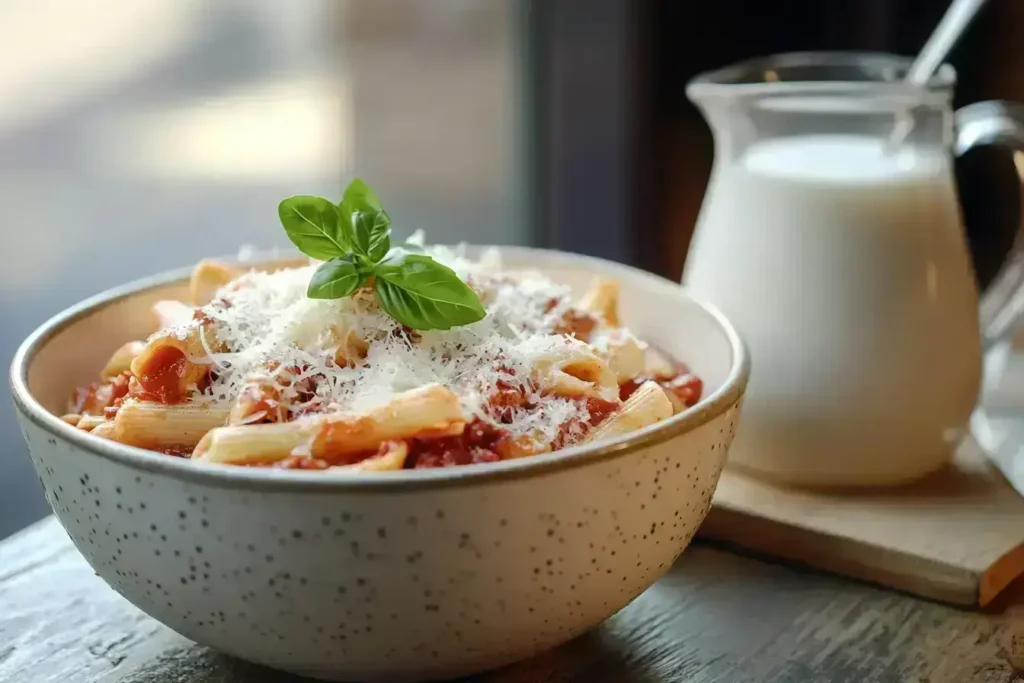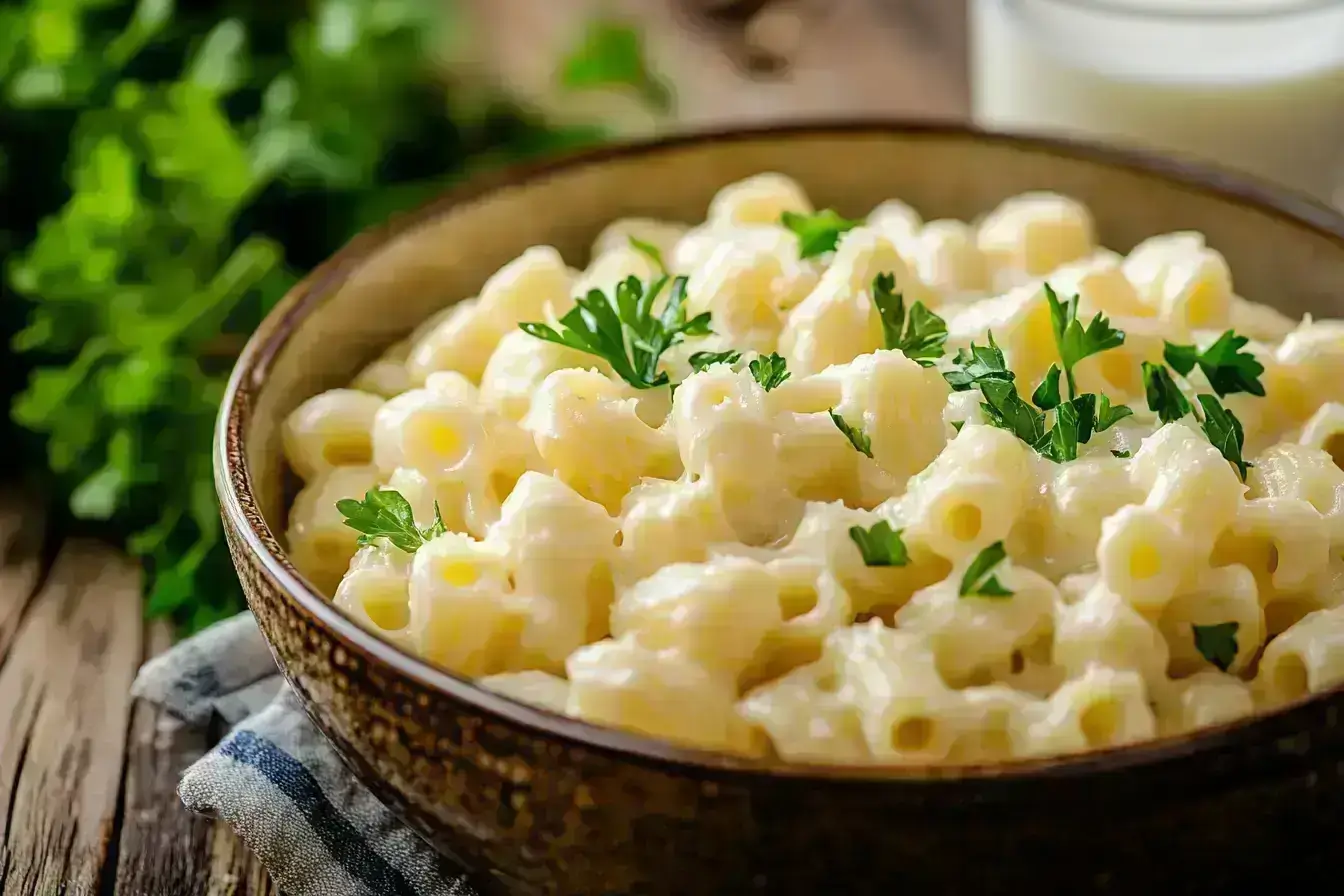Why This Question Matters
If you’ve ever stood in your kitchen halfway through cooking and realized you’re out of cream, you’re not alone. Many of us have faced this situation and wondered, “Can I use milk instead of cream in pasta?” The short answer is yes, but there’s a lot more to it. Let’s dive into the details and figure out how to turn a potential kitchen disaster into a creamy success.
Whether you’re looking for a healthier alternative, saving a trip to the grocery store, or experimenting with new flavors, milk can be a surprisingly good substitute. But there’s a catch—it’s all about knowing how to work with it.
Differences Between Milk and Cream
Before swapping milk for cream, let’s look at their differences. After all, understanding the basics can help you achieve the perfect creamy pasta sauce.
Texture and Consistency
Cream, particularly heavy cream, is much thicker than milk. Its high-fat content (around 36-40%) gives sauces a rich, velvety texture that clings beautifully to pasta. Milk, on the other hand, has far less fat (around 1-3% for regular milk). This means it’s much thinner and won’t naturally create the same luscious consistency.
Pro Tip: When substituting milk, add a thickener like flour, cornstarch, or grated cheese to mimic cream’s thickness.
Flavor Profiles in Pasta Dishes
Cream offers a neutral, rich flavor that enhances the overall dish without overpowering it. Milk, while also mild, can sometimes lack the depth that cream provides. However, with the right seasoning, milk can deliver a comparable flavor.
Nutritional Variances: Which Is Healthier?
One big reason you might want to use milk instead of cream is health. Cream is calorie-dense, with higher fat content that can quickly rack up your calorie count. Milk, especially low-fat or plant-based options, is lighter and can make your pasta feel less indulgent while still being delicious.
When to Use Milk Instead of Cream
Knowing when milk can work as a substitute is crucial. It’s not a one-size-fits-all solution, but it works wonders in the right scenarios.
Ideal Scenarios for Substituting Milk
Milk is an excellent choice if you’re making:
- Light pasta sauces: Think garlic butter sauces or subtle tomato-based creams.
- Dairy-heavy recipes: Add cheese to enhance richness while using milk as the base.
- Low-calorie dishes: Milk keeps your meals healthier without sacrificing too much flavor.
When Milk Won’t Work as a Substitute
While milk is versatile, it won’t always work:
- High-fat sauces like Alfredo: The lack of fat may make the sauce too thin.
- Recipes requiring whipping cream: Milk won’t hold its shape or create frothy textures.
- Heat-sensitive dishes: Milk is more prone to curdling than cream under high heat.
Important Note: When using milk, avoid boiling it for too long to prevent curdling.
Step-by-Step Guide: Replacing Cream with Milk in Pasta
Let’s get practical. Here’s how you can swap cream for milk without sacrificing flavor or texture.
Ingredients Needed
Here’s what you’ll need to get started:
- 2 cups of milk (whole milk works best)
- 2 tablespoons of butter or olive oil
- 1-2 tablespoons of flour or cornstarch (optional, for thickening)
- Parmesan or cheddar cheese (optional, for added creaminess)
- Salt, pepper, and garlic powder (for flavor)
Cooking Tips and Techniques
Follow these steps to create a creamy pasta sauce using milk:
- Heat the Fat: Start by melting butter or heating olive oil in a pan over medium heat. This adds richness and creates a base for your sauce.
- Thicken the Milk: If you want a thicker sauce, whisk the milk with flour or cornstarch before adding it to the pan.
- Simmer, Don’t Boil: Add the milk slowly, stirring constantly. Keep the heat low to medium to avoid curdling.
- Enhance with Cheese: Stir in grated cheese to boost creaminess and flavor.
- Season to Taste: Finish with salt, pepper, and your favorite herbs like basil or parsley.
Balancing Flavor: Adding Thickness and Richness
If your sauce feels too thin, try these tricks:
- Add grated cheese, which not only thickens but also adds depth of flavor.
- Use a cornstarch slurry (1 tablespoon cornstarch mixed with 2 tablespoons water).
- Simmer the sauce for a few extra minutes, allowing it to naturally reduce.
Block Quote: “Cooking pasta with milk isn’t just a substitute—it’s a chance to get creative and make the recipe your own!”
Common Problems When Using Milk in Pasta
Even with the best intentions, things can go wrong. Here’s how to troubleshoot common issues.
Sauce Too Thin? How to Fix It
If your milk-based sauce isn’t thick enough:
- Add a spoonful of flour or cornstarch.
- Stir in more cheese for an instant thickening boost.
- Let the sauce reduce on low heat, stirring occasionally.
Preventing Milk from Curdling
Milk has a pesky tendency to curdle, especially when exposed to high heat or acidic ingredients like tomatoes or lemon. To avoid this:
- Cook on low to medium heat. Never let the sauce boil.
- Add acidic ingredients after the sauce is finished.
- Use a pinch of baking soda to neutralize acidity.
Advantages of Using Milk Over Cream
If you’re still on the fence about whether to use milk instead of cream in your pasta, let’s weigh the benefits. Sometimes, choosing milk isn’t just about necessity—it’s a deliberate choice with plenty of perks.
Cost-Effectiveness
Let’s be honest—cream can be pricey. If you’re cooking on a budget or simply trying to make the most of what’s already in your fridge, milk is a fantastic alternative. It’s cheaper, more versatile, and you’re likely to have it on hand.
Quick Tip: Pair milk with pantry staples like flour or cheese to make a budget-friendly sauce that tastes luxurious.
Health Benefits
Milk is the healthier choice for anyone watching their calorie or fat intake. Here’s how it stacks up against cream:
- Lower in Calories: Whole milk contains about 150 calories per cup, while heavy cream packs over 800!
- Less Fat: Milk’s fat content ranges from 0% (skim) to 3.5% (whole milk), making it much lighter than cream, which can reach 40% fat.
- Nutritional Value: Milk is a good source of calcium and protein, adding a small nutritional boost to your pasta dishes.
Creative Pasta Recipes Using Milk
Ready to experiment? Using milk instead of cream opens up a world of culinary creativity. Here are a few simple yet delicious recipes to get you started.
Creamy Alfredo with Milk
This lighter take on Alfredo sauce keeps all the creaminess but ditches the extra fat.
Ingredients:
- 2 cups whole milk
- 2 tablespoons butter
- 2 tablespoons flour
- ½ cup Parmesan cheese
- Garlic powder, salt, and pepper to taste
Steps:
- Melt butter in a saucepan and whisk in the flour to make a roux.
- Slowly pour in the milk, whisking constantly to prevent lumps.
- Simmer until thickened, then stir in Parmesan cheese and seasonings.
- Toss with cooked pasta and garnish with parsley.
Carbonara Twist Using Milk
Traditional carbonara calls for cream and eggs, but this version uses milk to create a creamy sauce with a twist.
Ingredients:
- 1 cup whole milk
- 2 egg yolks
- 1 cup grated Pecorino Romano or Parmesan cheese
- 4 oz pancetta or bacon
- Freshly cracked black pepper
Steps:
- Cook the pancetta until crispy, then set it aside.
- In a bowl, whisk together milk, egg yolks, and cheese.
- Toss hot, cooked pasta with the milk mixture and pancetta, letting the heat create a silky sauce.
- Sprinkle generously with black pepper and enjoy.
Vegan-Friendly Creamy Pasta Options
What if you’re lactose-intolerant or vegan? Don’t worry—plant-based milk works too!
Best Choices for Creamy Pasta:
- Oat Milk: Naturally creamy and mild in flavor.
- Cashew Milk: Richer and closer to cream’s texture.
- Soy Milk: A versatile option that works in most recipes.
Pro Tip: For extra creaminess, add a spoonful of nutritional yeast or cashew butter.
Expert Tips for Perfect Creamy Pasta Without Cream
Here are some kitchen hacks to elevate your milk-based pasta game to the next level:
- Use Full-Fat Milk: Whole milk provides the best balance of creaminess and flavor.
- Thicken Strategically: Don’t hesitate to add cheese, butter, or a roux to achieve that velvety texture.
- Season Generously: Milk is more subtle in flavor than cream, so amp up your seasoning with garlic, herbs, and spices.
- Avoid Boiling: Always simmer milk-based sauces to prevent curdling.
- Pair with Rich Toppings: Use ingredients like crispy bacon, sautéed mushrooms, or roasted veggies to add texture and flavor.
Block Quote: “Think of milk as a blank canvas—what you add to it determines how amazing your pasta sauce turns out.”
Comparative Chart: Milk vs. Cream in Pasta
A quick reference chart can help you decide when to use milk instead of cream for your pasta dishes. Here’s how they stack up:
| Aspect | Milk | Cream |
|---|---|---|
| Texture | Thinner, less creamy | Rich, velvety, and thick |
| Flavor | Mild, slightly sweet | Rich and neutral, enhances other flavors |
| Fat Content | Low (1–3.5%) | High (36–40%) |
| Calories | 150 per cup (whole milk) | 800+ per cup |
| Health Benefits | Contains calcium and protein, lower in fat | Calorie-dense, less nutritious |
| Cost | Affordable and widely available | Expensive and less commonly stocked |
| Suitability for Pasta | Works well with additional thickeners | Perfect for creamy dishes without adjustment |
Frequently Asked Questions (FAQs)
Here are answers to some common questions about using milk as a substitute for cream in pasta.
Can I Use Plant-Based Milk for Creamy Pasta?
Absolutely! Many plant-based milks work well in creamy pasta dishes, but some are better than others:
- Best Options: Oat milk, cashew milk, and soy milk. These are naturally creamy and have neutral flavors.
- Avoid: Almond milk or rice milk as they are thinner and less creamy.
Pro Tip: Add a tablespoon of nutritional yeast to enhance the cheesy, umami flavor when using plant-based milk.
Will Milk Work in Baked Pasta Dishes?
Yes, milk works in baked pasta dishes like lasagna or baked ziti, but you may need to adjust the recipe slightly:
- Use whole milk for the best results.
- Thicken the milk-based sauce before mixing it with pasta. This prevents the sauce from becoming watery during baking.
- Add shredded cheese or breadcrumbs on top for a golden, crunchy crust.
How Do I Store Milk-Based Pasta Sauce?
Milk-based sauces can be stored in the refrigerator for up to 3 days:
- Cool the sauce completely before transferring it to an airtight container.
- Reheat gently on low heat, adding a splash of milk or broth to restore its consistency.
- Avoid freezing, as milk-based sauces tend to separate when thawed.
Bonus Recipes
Here are a few more milk-based pasta recipes to try in your kitchen.
Milk-Based Mac and Cheese

This version of mac and cheese is lighter yet just as comforting.
Ingredients:
- 2 cups milk
- 2 cups shredded cheddar cheese
- 1 tablespoon butter
- 1 tablespoon flour
- ½ teaspoon mustard powder
- Salt and pepper to taste
- 2 cups cooked elbow pasta
Steps:
- Melt butter in a saucepan, whisk in flour, and cook for 1 minute.
- Slowly add milk, whisking until thickened.
- Stir in cheese, mustard powder, and seasonings.
- Combine the sauce with cooked pasta and serve warm.
Milk and Tomato Cream Sauce
This sauce combines milk and tomato for a rich, pink sauce.
Ingredients:
- 1 cup milk
- 1 can crushed tomatoes
- 2 cloves garlic, minced
- 1 tablespoon olive oil
- 1 teaspoon sugar
- Salt, pepper, and basil to taste
Steps:
- Heat olive oil and sauté garlic until fragrant.
- Add crushed tomatoes, sugar, and seasonings. Simmer for 10 minutes.
- Slowly stir in milk, cooking on low heat until creamy.
- Toss with pasta and garnish with fresh basil.
Spicy Cajun Pasta Using Milk
This dish is perfect for spice lovers.
Ingredients:
- 1 cup milk
- 1 tablespoon Cajun seasoning
- 2 tablespoons butter
- 1 tablespoon flour
- ½ cup grated Parmesan cheese
- 1 cup cooked chicken or shrimp
- 2 cups cooked penne pasta
Steps:
- Melt butter, whisk in flour, and cook for 1 minute.
- Add milk and Cajun seasoning, stirring until thickened.
- Stir in Parmesan cheese and cooked protein.
- Toss with pasta and enjoy the spicy kick!
Myths and Misconceptions
When it comes to using milk in pasta dishes, some myths persist. Let’s debunk them:
Myth 1: Milk Can’t Create a Creamy Sauce
Truth: Milk alone may not be as thick as cream, but with simple adjustments like adding flour, cornstarch, or cheese, you can achieve a creamy consistency.
Myth 2: Milk Always Curdles in Pasta Sauces
Truth: Milk is more prone to curdling, but this can be avoided by cooking on low heat and adding acidic ingredients (like tomatoes or lemon) at the end.
Myth 3: Substituting Milk Will Ruin the Flavor
Truth: Milk has a lighter flavor than cream, but this opens up opportunities to add other seasonings, herbs, and cheeses for a customized taste.
Explore More Delicious Recipes to Elevate Your Pasta Dishes
If you’re exploring different ways to enhance your pasta dishes, you might also enjoy experimenting with creamy mushroom gnocchi, which delivers a rich, velvety texture even without heavy cream. Additionally, if you’re interested in hearty soups, consider trying a Tuscan bean soup, a satisfying meal that pairs beautifully with rustic bread. And for those who love a meaty twist on pasta, check out this beef steak pasta recipe, which balances bold flavors with tender, juicy steak.
Conclusion: Yes, Milk Is the Secret Ingredient You’ve Been Missing!
Using milk instead of cream in pasta isn’t just a substitute—it’s a game-changer. Whether you’re seeking a healthier option, looking to save money, or simply experimenting with new techniques, milk has your back. With the right adjustments, milk-based sauces can be just as creamy, flavorful, and satisfying as those made with cream.
So, the next time you’re making pasta, skip the cream and give milk a try. It’s an opportunity to get creative, save calories, and still enjoy the comforting taste of a creamy pasta dish.

